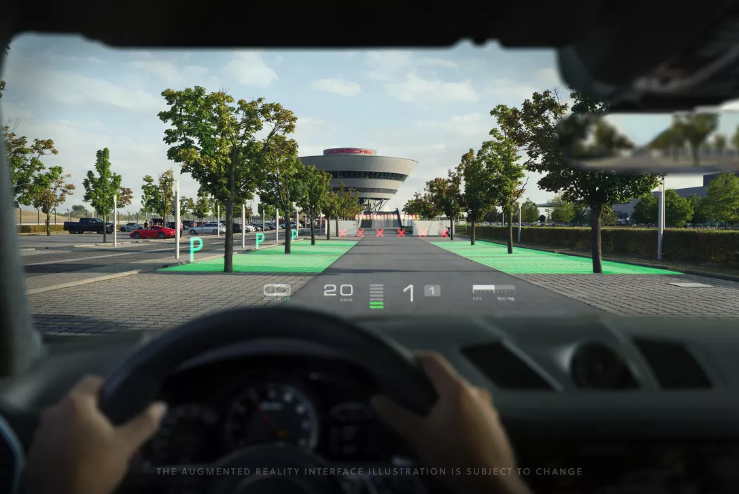Augmented Reality Apps Will Soon Show Up on Your Car Windshield
Augmented reality applications are developing along two parallel segments. There are the AR fun apps and games such as Lego Studio and Pokemon Go which are just for entertainment. Then there are functional or useful augmented reality apps that are increasingly playing a useful role in diverse industries ranging from the retail applications to usage in remote assistance, navigation, medical applications and in design and manufacturing applications among others.
One of the most enthusiastic AR adopters has been the automotive industry with some of the leading car makers such as BMW, Mercedes and Toyota among others leading the pack in implementing AR into its systems. Applications have ranged from the design and manufacturing work in shopfloors to marketing and cabin entertainment.

In the future, our augmented reality experiences will move away into an essential everyday experience and away from the head-mounted or face-mounted devices into more elegant implementations that will not require a lot of hardware.
Essentially, augmented reality adds layers of digital data over the user’s reality. Augmented reality is primarily based on overlaying visuals although with the advancements in AR audio and haptics, it is now possible to overlay sound and a sense of touch. The default augmented reality applications involve the addition of something into your view of reality although in some instances, it will also entail a virtual subtraction from your environment.
Creating Visibility in Cars
In the automotive sector, one of the most critical areas where augmented reality solutions and innovations are being directed is in solving issues to do with obstructed visibility. The GMC 2020 pickups will, for example, offer drivers a transparent trailer view option.
This functionality leverages the camera view on the back of the trailer and superimposes it over the driver’s actual view through a dashboard screen so as to make the trailer being pulled to disappear.
Land Rover has also come up with an augmented reality implementation that makes the front part of the 2020 Evoque to disappear while ensuring the tough terrain the driver is traversing remains visible.
Jaguar once did a transparent pillar AR in 2014 although it has yet to unveil it in the market probably due to the fact that the automaker hasn’t come up with the right technology that will superimpose the pillars in OLED rather than cameras. There is the Samsung Galaxy Fold but its folding screen technology has had issues so carmakers are unlikely to adopt this until the technology is bullet-proof.
Understanding the Maps
The rise of smartphones has revolutionized maps but even with mobile apps, a lot of people still struggle with map-reading.
The use of augmented reality maps is likely to make map reading so simple and intuitive that you will be able to figure it out even with zero map or directional comprehension. Even if you have problems with angles or the compass orientations, augmented reality can make getting your directions right as easy as having a physical guide to show you the way.
They make maps more understandable and this navigation will soon be delivered onto your car dashboard screen. Mercedes is one of the early adopters of augmented reality navigation in its latest GLE and A Class models where nav instructions are overlaid over objects through the user’s live camera view. In this application, objects such as turn instructions and street names will pop out as the driver approaches the next turn.
Future augmented reality innovations will see such applications moving from the vehicle dashboard screen onto the windshield thereby keeping the driver’s eyes focused on the road. Mercedes has already showcased this through its DICE concept which provides a full-screen and head-up AR experience on the road.
Another key player, WayRay, recently launched a wide-screen laser photography projector which allows for the creation of full-screen augmented reality.
Using Augmented Reality to Kill Boredom During Drives
We are moving towards a future where autonomous cars will increasingly become a common fixture on our roads. But what does the driver do when the car is self-driving? One aspect of these cars will be the boredom and some have proposed the use of virtual reality and augmented reality as a means of killing boredom in autonomous vehicles. It could be possible to create rich augmentation in autonomous cars using AR but without the encumbrances of the head-mounted or face-worn goggles.
In the near term, we are going to see more automakers incorporating augmented reality as a marketing tool that users can deploy to preview car models before they make a purchase. There are already some good examples of this such as in the Mission E AR app for the Porsche as well as the Coaster AR app for Audi Quattro. Both apps provide users with clever and game-style experiences that they can open and use to engage with the auto brands before they even visit the showrooms.
BMW, for example, has an augmented reality car configurator app that allows users to select their car, pick colors and options and even get in the car or walk around it. The app enables you to project a BMW car to your driveway and garage so you can get a virtual “feel” of it before you walk into the showroom.
https://virtualrealitytimes.com/2019/06/20/augmented-reality-apps-will-soon-show-up-on-your-car-windshield/https://virtualrealitytimes.com/wp-content/uploads/2019/06/Transparent-Trailer-Rear-Camera-View-600x371.pnghttps://virtualrealitytimes.com/wp-content/uploads/2019/06/Transparent-Trailer-Rear-Camera-View-150x90.pngAugmented RealityTechnologyAugmented reality applications are developing along two parallel segments. There are the AR fun apps and games such as Lego Studio and Pokemon Go which are just for entertainment. Then there are functional or useful augmented reality apps that are increasingly playing a useful role in diverse industries ranging...Sam OchanjiSam Ochanji[email protected]SubscriberVirtual Reality Times - Metaverse & VR
